Article last updated September 2, 2022
How to Create a Template in Confluence (Ultimate Guide 2022)
Companies often find it challenging to standardize documentation and make sure everyone inside the team follows clear guidelines and can access the right data at the right moment. Documents can be anything from meeting notes, project planning, technical documentation, to strategic one-pager plans, employee onboarding, and so on. With the ease for everyone to create content in Confluence, comes the challenge of professional knowledge management to avoid chaos. And that’s where Confluence templates come in!
Confluence templates take your content creation to the next level by automating formatting and allowing data to be structured for everyone. Creating Confluence templates is pretty easy but in order to make the most out of them, you have to follow some clever steps.
In this guide you'll also learn how to use your templates with 3rd party apps such as Meetical. If you are familiar with Templates and use Meetical already, check our separate guide on How to use Templates with Meetical.
If you're interested in templates for meeting notes, you might also like to read our Ultimate Guide on Confluence Meeting Notes.
By following this guide you’ll promote a unified structure and layout for certain types of documents. This is especially important in Confluence because, with macros such as Page Properties, you can turn your pages into well-organized, semi-structured databases.
How this article is structured:
- In the Introduction to Confluence Templates, we'll discuss the basic ideas of templates, when you need to create a Confluence template, and the pre-made templates that are already available for you.
- In Creating a New Template we'll go through the types of templates you can create and how you can start doing that.
- In the Editing Existing Templates section, we will show you how to copy and edit existing templates and explain what Confluence blueprints are.
- In the Design and Layout section, we’ll go through the step-by-step process of creating new Confluence templates.
- In the Publishing Your Template section, we’ll explain how you can share your newly created template with teams and other Confluence users.
- In the Macros section, we’ll discuss the most powerful macros to use in templates.
- In the Meeting Notes Template section, we’ll show the best ways to use Confluence for internal and external meetings.
- The Best Practices section goes through nifty tips and tricks for Confluence power users.
- And finally, we’ll Summarize everything for you.
In this article, we have poured over 10 years of experience working with Atlassian tools so that you can start creating Confluence templates within minutes! So let’s dive in.
1. Introduction to Confluence Templates
In a nutshell, Confluence templates help you rein in your data. Every report, interview, transcript, campaign, epic, and brainstorming session creates a content dump that needs to be pruned, structured, and shared properly. You lose the track of data, you lose your progress.
You’ll need Confluence templates if:
- You’re going to create similar content, repeatedly. Think of regular interviews, feature requirements, employee onboarding, and frequently asked questions—if teams can replicate a set structure to document everything, you’ll retain all the important data and speed up everyone’s workflow by simultaneously reducing human errors.
- You want to standardize documentation across the company. It’s important to set content guidelines to reduce fragmented and incomplete data and increase overall trust in the Confluence database.
- You want to build semi-structured databases within Confluence. Powerful macros, such as Page Properties, combined with templates, help you build reliable document databases, categorize your pages, and help you maintain order in an ever-growing knowledge base.
Using the Confluence Template Library
You’ve decided to use Confluence templates to improve team productivity so you start creating your own. But hold on! Chances are, there’s a template that already exists for your needs. Confluence template library has a huge repository of done-for-you templates from Atlassian and its partners including Miro, Indeed, HubSpot, Zendesk, InVision, and Meetical. They cover almost every aspect of an organization—from business strategy, design, HR, and reports to project management, IT, marketing, startups, and agile teamwork.
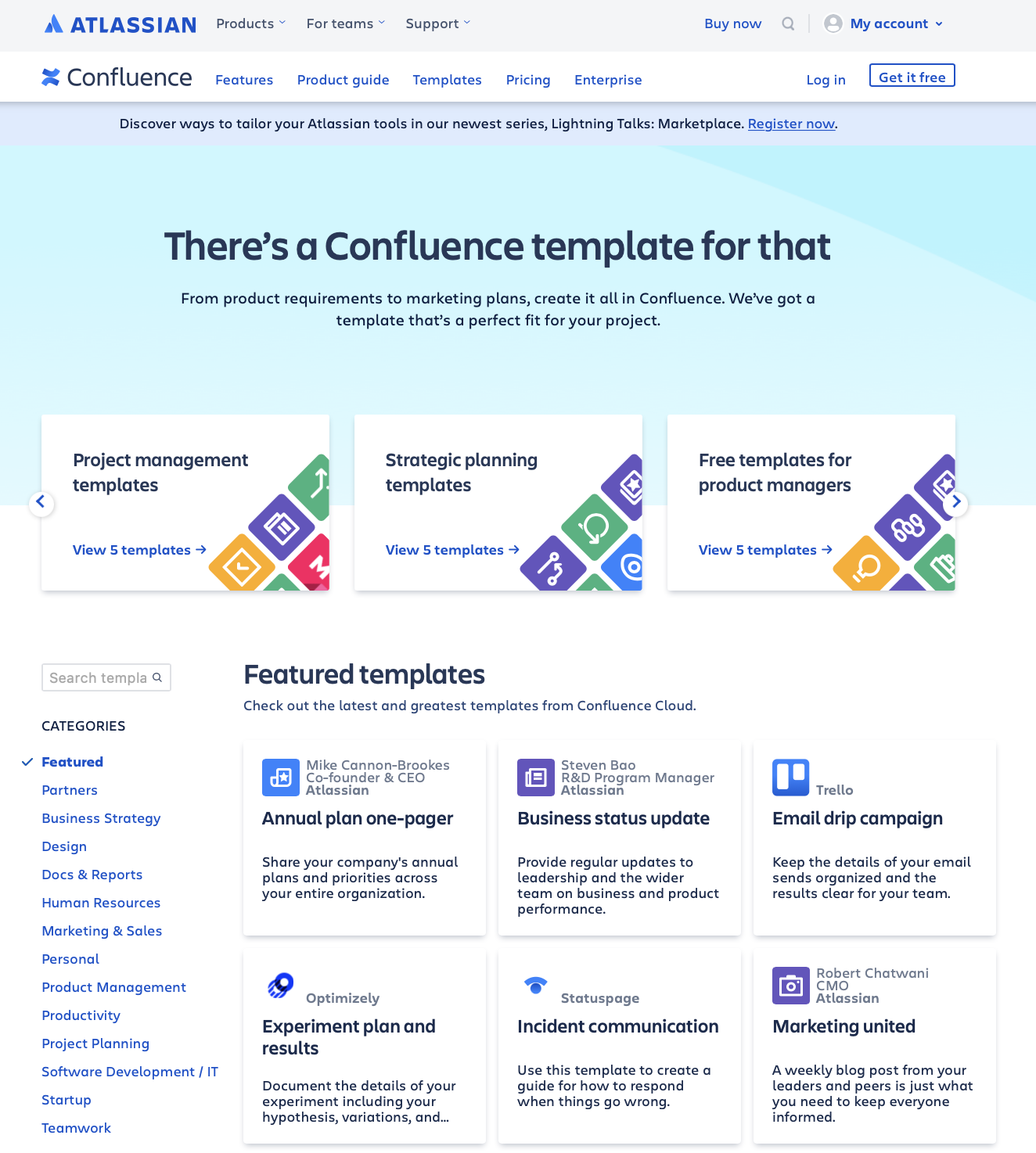
The templates are often updated with new features and the library is expanding every day. Some of our personal favorites are:
- Meeting notes template, Project plan template, DACI: Decision documentation template — for project managers
- Retrospective template, 4Ls retrospective template, Sprint planning meeting template, Daily stand up template — for agile teams
- 1-on-1 meeting template, Leadership team health monitor template, 5 whys analysis template — for team leaders and executives
Head over to the Confluence template library, search with your keywords and find the one that suits your needs!
Why create your own templates in Confluence
Despite boasting an exhaustive collection, the template library doesn’t work for every business. And that’s a good thing. You can create templates from scratch specifically for your organization and have more control over documentation. For example, at my previous company, we decided to simplify the pre-made meeting notes template with a simplified agenda table and two columns: “Agenda item” and “Results”, plus add a section for “Recordings” where we would upload Zoom recordings, when available.
Below we’ll show you how to create a template in Confluence and the tricks you need to follow to get the best results.
2. Creating a new template
You can create two types of templates: global templates and space templates. Global templates are available to everyone on your Atlassian site, while Space templates are useful for specific spaces within an organization.
Space templates help you demarcate project scope—for instance, the IT and development team doesn't need to see the drip campaigns of the marketing team. Whereas, Global templates are useful when you need a standard documentation style across the organization.
Global Templates
Creating global templates is easy.
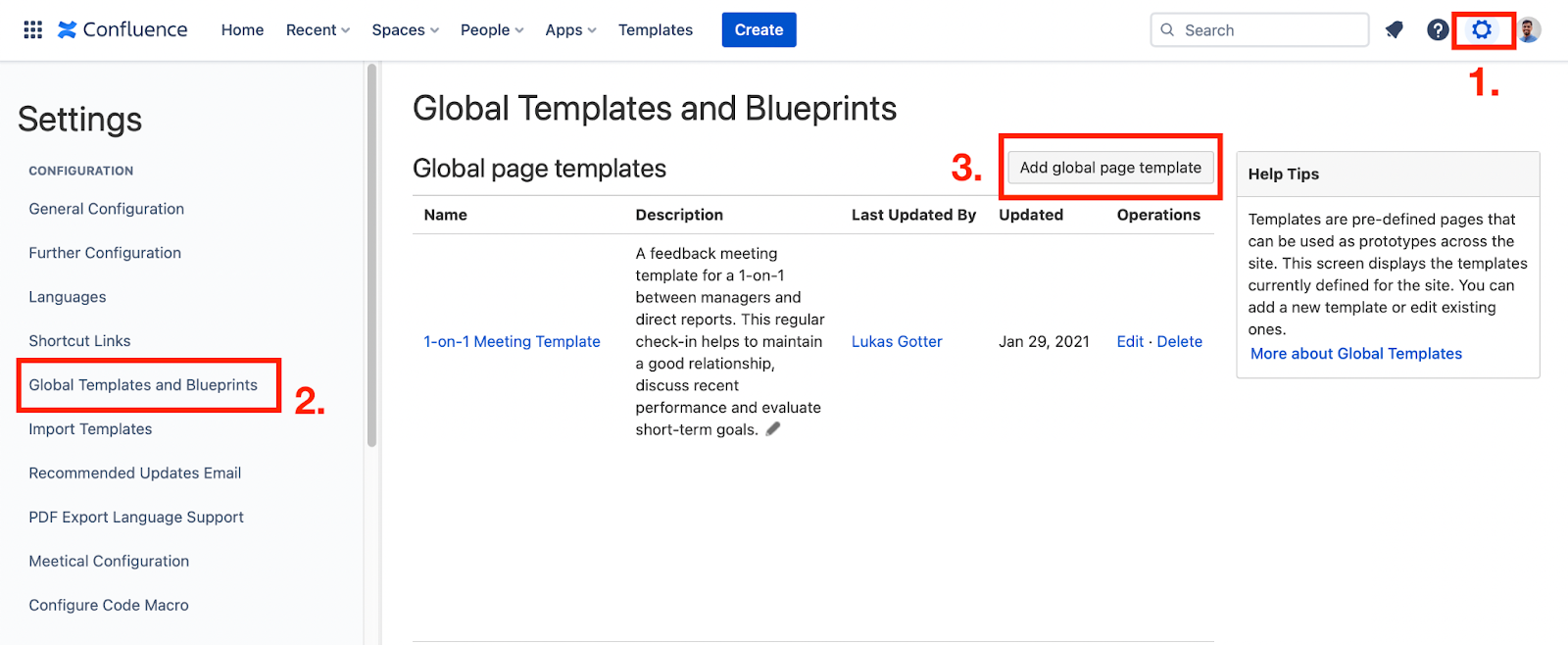
- Click on the gear icon at the top right and you'll be taken to the general configuration page
- Click on the Global Templates and Blueprints from the left sidebar
- Click on the Add global page template button
- You'll be taken to the page editor where you can edit the global template
- After editing, you can save the page as template in Confluence
Important to remember: you can only add/remove global templates as a Confluence site admin.
These are the simple steps to follow to create a template, we’ll soon see how to create a great layout and what macros we can use to get the most out of our templates.
Space Templates
Creating Space templates is as easy as creating global templates. It’s a good option if you only want to make your template available for your team/project, or if you simply don’t have the privileges to create global templates.
Create a Space template by following these steps:

- Open the Space you want to create the template for
- Click on the Space Settings from the left sidebar
- Then click on Look and feel
- Go to the templates window and select Create New Template
- You'll be taken to the page editor where you can edit the space template
- After editing, you can save the page as template in Confluence
Important to remember: you can only add/remove space templates as a Confluence Space admin. Site admins can give that privilege to users for each space. To get started with space templates, use your personal space, where you have Space Admin privileges by default.
What is a Confluence blueprint?
If you have reached this far, you must have come across Confluence blueprints, especially while creating global templates. Blueprints share a lot of similarities with the templates you create so it's important to know the difference.
Here’s what you need to know about blueprints, right from Atlassian — “Blueprints are templates created by Atlassian or by third-party developers. From an end-user perspective, blueprints and templates are the same, but there are some important differences for administrators.”
In a nutshell, blueprints are templates with steroids and by steroids, we mean coding skills. You need to write plugins for each blueprint but this gives you more under-the-hood control over the content structure. For example, if you use the meeting notes blueprint for the first time, Confluence will create a meeting notes index page, listing all meetings and action items in that space.
But Unless you have development skills, it doesn’t make sense to write plugins and create blueprints—you’re better off creating your own template instead.
Testing your templates
After creating your templates, you have to see how they perform. You can find your templates in the lists and test them in three ways:
a) Using your Personal Space
Your personal space is the best and most safe way to get started with templates. Just click on your user profile icon on the top right and either “Create personal space” or access your existing personal space from there.

b) Using Space Templates
If you’re looking into a solution that works for your whole team or project, then we recommend you use Space templates. You only require space admin rights to be able to create and edit these templates.

c) Testing Global Templates
Global templates are the best way to standardize content across your whole organization. However, Confluence Admin rights are required. You might also request temporary access if you think everyone in your company can benefit from your templates.

3. Editing existing Confluence templates
You can use these steps to copy existing templates and or turn any existing Confluence page into a template. We suggest you use a regular page to design the template and then copy it over to your template editor.
Copy templates
It’s always a good idea to create a page first and bring an existing template to see how it looks. To copy or clone an existing template and edit it in your space, here’s how what you need to do:
- Click on the Global Templates and Blueprints from the sidebar, find the template and click edit
- Press Ctrl+A or command+A to select the entire text
- Press Ctrl+C or command+C to copy
- Return to the previous page, and click on Create New Template button
- Press Ctrl+V or command+V to paste the template
This process works equally well while turning any Confluence page into a template. Just copy the whole content with Ctrl+A or command+A and paste it into a new template. Make sure to go over all macro settings and see that there aren’t any hard-coded page IDs or space key references. More on that later when we speak about adding macros.
Edit existing templates
Editing existing Confluence templates is seamless as well. To easily edit Confluence template, click on the edit button and start tweaking the elements in the editor!

You can also edit the built-in templates and blueprints such as meeting notes. Simply find the blueprint/ template and click on the edit button next to it. Want a different meeting notes index page to be created with your first meeting notes page in any new space? Then choose the second template in the Blueprints section and edit that page.

Yes, both the index page and the actual template have the same name, this can be a little confusing and is probably a bug at the time of writing. Atlassian hopefully renames the second entry to “Meeting Notes Index Page” as it should be.
We’ve seen how to edit Confluence templates, now let’s create a great design and layout for our templates.
Turn normal pages into templates
Unfortunately, this is not a native Confluence feature. To turn a Confluence page into a template, you can simply copy a page’s content, as outlined in the copy template section. Then paste everything into the template editor. Make sure you double-check all macros to not include hard-coded space keys or similar.
Import external documents and turn them into Confluence templates
Confluence lets you import documents from OneDrive, Microsoft Word, and Google Docs so you can quickly work with them in Confluence. It’s a very useful feature if your company has a lot of external documentation and is planning to streamline with Confluence. Just click on the ‘Create’ button and the right sidebar would have an import button ready for you!
Then, use the same process as we already described in copying a template to turn these pages into templates.
4. Design and layout your templates
The first thing you need to do is experiment with the template layout and structure to make it look and feel just the way you want.
Layout, texts, and tables
First of all, pages can have a full-width or fixed width, with all content centered. We recommend the fixed width, for a modern look of your Confluence page, as long as you don’t really require the entire space.
Next, you can either keep the simple one-column layout or use the “/” command to find multi-column layouts for your template. Alternatively, use the Layout or “Add Macro” control on the top right of the editor icons.
For layouts, you can use various widths of the columns and headline structure. Decide wisely if you want to use a column layout or use a simple page and combine it with a table. Tables are more flexible and also come with features such as sorting and numbering. Layouts are better to structure content and make some sort of text easily readable.
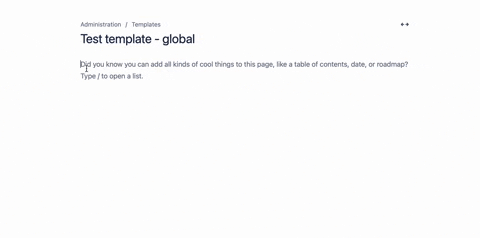
For content structure, use the pyramid style—put the most important information at the top, marked with H1 and H2, and slowly scroll down for other segments. If you press the shortcut command+option+1/2/3/4, you can quickly switch between heading sizes.
Also note that you can combine a fixed-width page, and add a full-width macro, such as a table. Use this approach, if you only require more space for a specific section of your page.
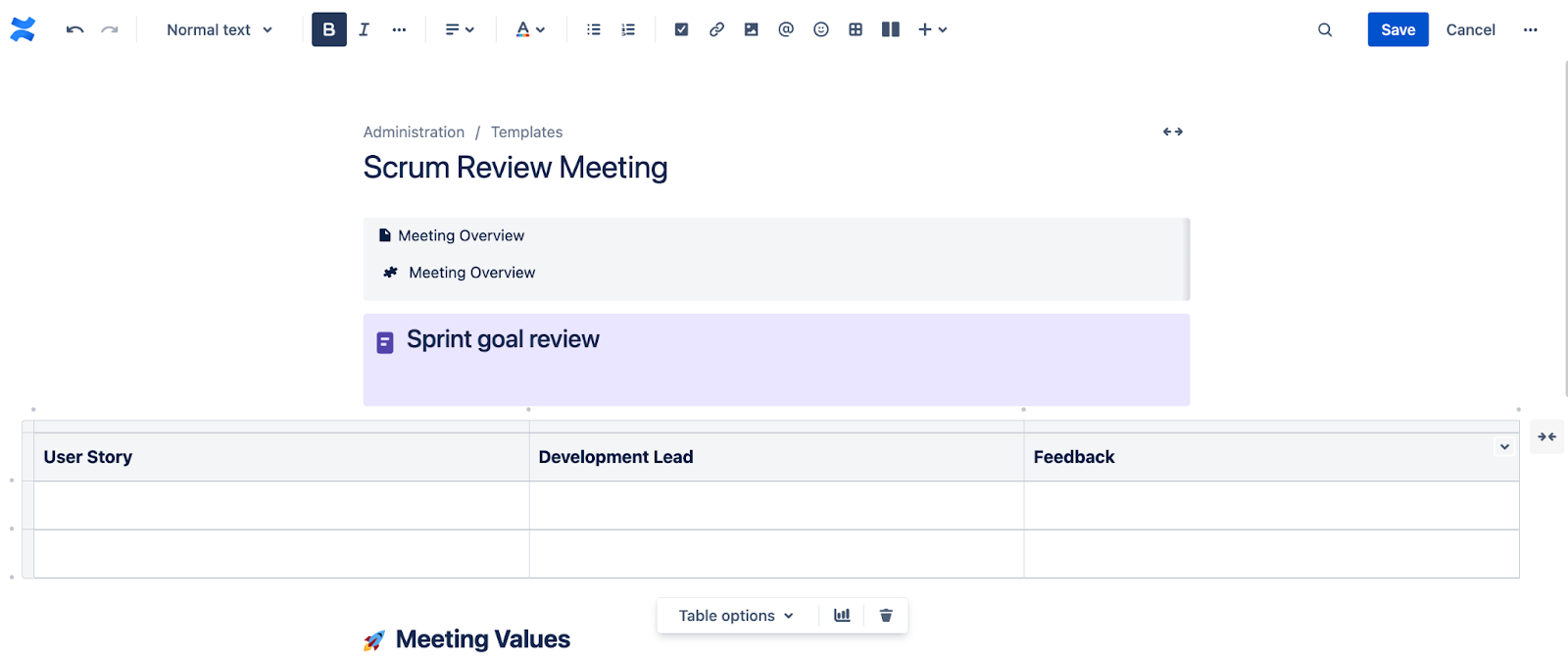
Adding macros
Macros are like extensions that take your templates to a whole new level. The added functionalities of macros are useful for teams with complex tasks as documentation becomes a whole lot easier.
Just press “/” in the editor and start picking and editing the macros you want to use. For example, use the “Page Tree Search” macro, and place it on your template. This way all pages you create from that template will contain a search, which provides a quick way to search any pages under the create page.

If you’re going to create multiple pages and want to categorize them easily, we suggest using Page Properties: the page properties macro and page properties report macro.
You have hundreds of options to choose from, but not all macros are suited well to be used on templates. If you want to learn more about the most useful macros, more on that in a later section.
Besides the built-in macros, the Atlassian Marketplace offers even more options and customizations. You can add these third-party macros on your templates too, such as the Meetical macros!
Adding third-party party macros
Macros are not limited to defaults. You can use third-party macros that are created to address niche use cases. For example, if you want to use the Meetical Meeting Overview macro to show an overview and list all meeting attendees, type “/”, search for “Meetical” macros, and add them to the page. We suggest you start with the meeting overview macro that comes with a done-for-you overview table.
Here’s how it looks:

Placeholder text
Placeholder text is a nifty feature that acts as a guide and a reminder to fill the right data in the right section. You can also describe what needs to be done now and what needs to be done later, within due dates. If team members don’t replace the placeholder text with meaningful data, it will hang in there, reminding people what to do next.
With status macros, dates, and decision macros you make placeholder texts even clearer and all the team members can start filling out the data.
Template Variables
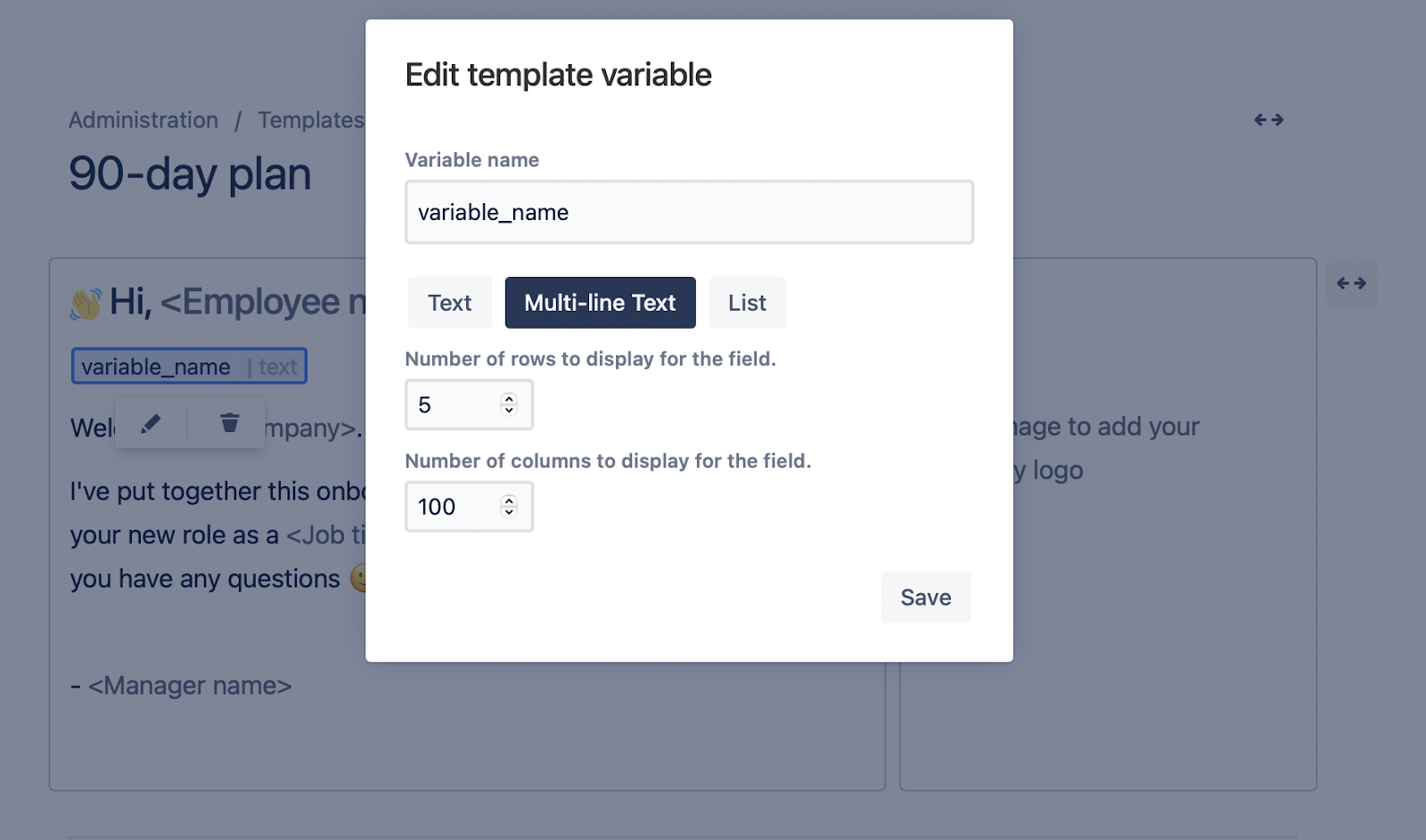
Template variables are super useful macros that add a new layer of data standardization in Confluence pages. Variables come with form fields. When someone creates a page from your template they’ll have to fill in the variables which will show up on the page. You can change the Confluence template variable name and decide how the form field would appear. For instance, multi-line text would be useful for sales teams that are recording multiple quotes and other conditions on the pages.
Create from Template Button / Macro
The “Create from template” macro is one of the most powerful shortcuts your team can use to quickly load a new page from a template. It saves a lot of time for recurring processes and makes sure your team is documenting exactly the way you created the template.
If you are using Meetical for your Meeting Notes, this button is less important, since you create your meeting pages directly from your Calendar events. However, there is an alternative macro included with Meetical: The Create from Meeting Calendar Button. It will lead users to the Confluence Meeting Calendar to create meeting pages.
When using the Create from Template macro in combination with your template, users will be prompted to fill out any variables you defined. Additionally, the macro allows you to use specific variables in your page title, like the current date or space name.
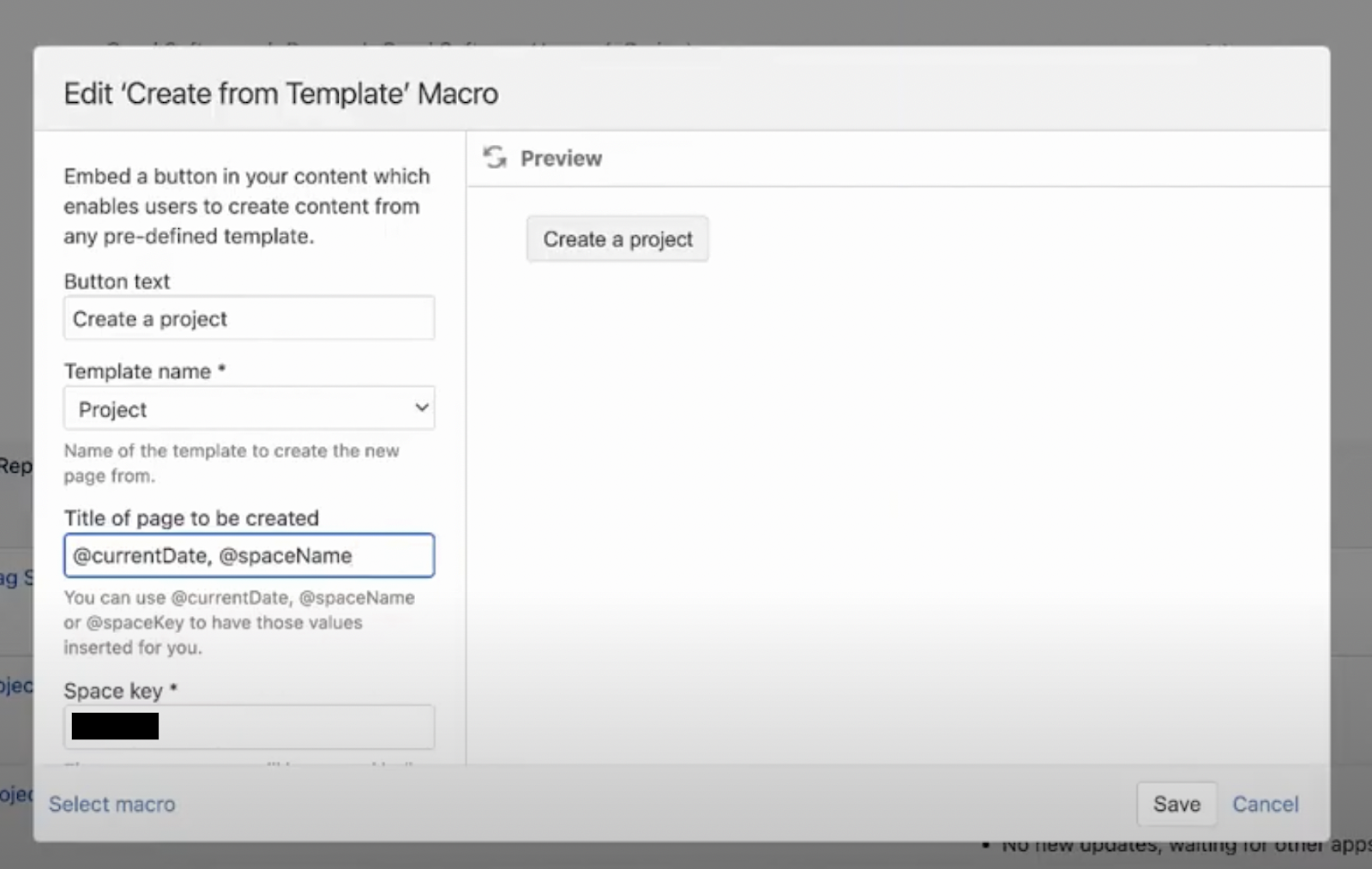
Here’s how to embed the “Create from Template” button:
- Type “/” in the editor and search for the Create from template macro
- Give the call-to-action button a descriptive name to make it clear what the user should create. For example, if they’re looking for a project description page, write something like “Create a project”.
- Find and select your template from the template list
- To automate page titles, use @currentDate and @spaceName. This way, all the pages that are created with the button will have the current date and space name at the beginning of the title. You can also use @spaceKey to mention the space the pages should be put in.
Apply labels to every page created from your template
At this stage, you have a few templates and in a few months, you’ll have hundreds of pages based on them. It’s going to be almost impossible to sift through the vast amount of content dump to find a particular page. So how do you make templates and pages easily discoverable? With labels!

Labels are like tags that add searchable metadata to your pages and these are lifesavers in high-intensity workspaces. Just head over to the three-dot menu at the top-right in the Template Editor, select ‘Add Labels’, and type your relevant labels to tie the pages to a search tree.
Besides allowing users to search pages via labels, you can also generate various reports based on them.
For example, you can use the ‘Content by Label’ Macro and generate a report of all pages with the label ‘retrospectives’ in a space of your choice or even company-wide. Or you can use the ‘Decision Report’ macro, and show all decisions taken on pages with the label ‘retrospective’. A company-wide decision log, showing the power of Retrospectives, is pretty awesome, isn’t it?

5. Publishing your template
You have created your templates, tested them out and now it’s time to share the news. After all, you want people to start using your templates!
Make your template available for your team or the entire company
Space templates are easy to share and promote within a space. Give the template a clear name, and hit save! From the template list, you can add a short but detailed description to help teammates find it easily.
Promoting your template
To promote a template for everyone to use:
- Go to any space
- Select look and feel
- Find your template at the top and select “promote” under operations (next to the edit link)
When users create a new page they’ll be greeted with the Confluence template gallery in the sidebar and they’ll easily find the tag for promoted templates.

Making Templates available for Meetical
Once you create your meeting templates, you'd want them to be populated from your calendar by integrating your Calendar with Confluence. To add templates and make them available for Meetical, add the Meetical template label "meetical-template" to your template.
Select "Add labels" from the top right ... menu, type “meetical-template” and add that label. That's it!
For more the details, head over to the dedicated Templates for Meetical guide.
6. Most powerful macros to use in templates
Since macros come with all kinds of functionalities, your mileage would vary. But some macros are more powerful than others as you’d find yourself using them frequently. And when it comes to templates, any macros requiring a fixed parameter are less than ideal. Your templates should always have dynamic references, such as currentPage, currentSpace, etc.
Macros relative to the current page
The first category of useful macros are the ones that add features around the current page. In our case, the current page refers to the page a user creates from our template!
Here’s a list of ideas
- Add the Table of Content Macro to your template, to show an index of all headings on the page.
- Use the Change History Macro, to show a report of recently published versions of the current page, with the last versions of the current page.
- We can show a Related Labels Macro, to show labels of pages that have at least one label in common with the current page
- To show a list of people who authored, contributed, and commented on the current page, use the Contributor Macro

There are many possibilities and additional options on the Atlassian Marketplace! Next, let’s have a look at macros that can generate reports based on all subpages of the current page.
Macros reporting on sub-pages
Another bunch of macros that are popular among Confluence template creators are the ones that report on sub-pages and use current page filters. With the @self/current page filter, you can create powerful dynamic reports.
- To show a list of all sub-pages, relative to the current page, use the Children Display Macro.
- The Content by Label Macro can show a list of all sub-pages with specific labels. Since it supports the relative parent ‘Current page’, you can use it to show a report of all sub-pages which might get created under your template.
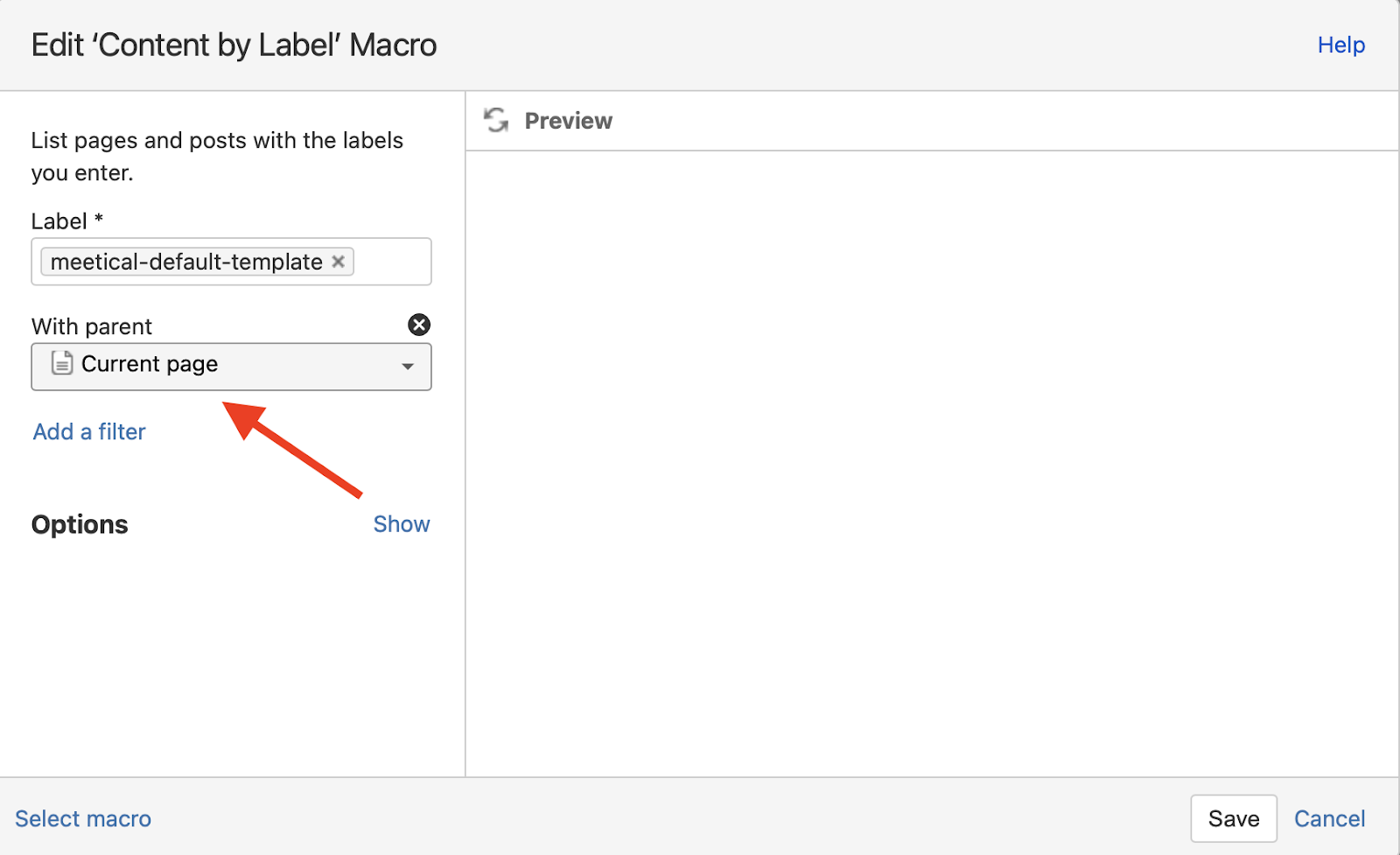
- If you want to provide a quick and easy search over all subpages of the current page, use the Page Tree Search Macro. The page tree macro supports a relative parent. Actually, the default search root is the current page, so no configuration is needed. Just place it on your template and the search field will search on all subpages of the current page which was created from the template.
- Also, the Decision report macro can be set up to show a report in relation to the current page. Simply choose “current page” as the ancestor and you’ll get a report on all decisions made on any sub-pages!

- Last but not least, there is the very useful Task Report Macro. Unfortunately, that macro currently does not support a dynamic filter to work out of the box relative to the current page. It’s a shame! For our Confluence App Meetical, we created a feature, that all recurring meetings are automatically grouped under a common parent page. We wanted to show a task list for each meeting series, but found out this was harder than we thought. Fortunately, we found a workaround, and now every occurrence shows a list of all open tasks in the series! Even better, so you can start the meeting by reviewing all open action items in the series. That macro works on pages created from the Calendar with Meetical. For your own templates, a possible workaround could be this: Add a placeholder text next to the macro to remind the template user that there is work to be done. Another idea could be to use a specific label all sub pages and apply a label filter. Not ideal but could work.
Hopefully, this feature will be implemented in the future! You can vote for it here, and don’t forget to mention your use case.

.
And there is one more special macro category to be mentioned here: Page Properties macro. We created an entire chapter here to honor the power of these macros.
7. The Power of Page Properties in Confluence Templates
This guide wouldn’t be complete without mentioning Confluence Page Properties in detail. Placing page properties on your templates, and combining them with template variables, placeholders, and reporting macros, is one of the many reasons Confluence users simply love this tool.
To demonstrate this, we’ll create a simple OKR template and turn our pages into a manageable database!
1. Create a new template named “Key result”
2. Add the label “key-result” to the template
3. Add the page properties macro, and add a table as indicated below

4. Save the template and create a new page “OKR overview”
5. Add the “Create from template” button to the page – choose the “Key result” template when configuring the macro

6. Add a Page Properties Report Macro, and choose "key-result" as the label when configuring the macro
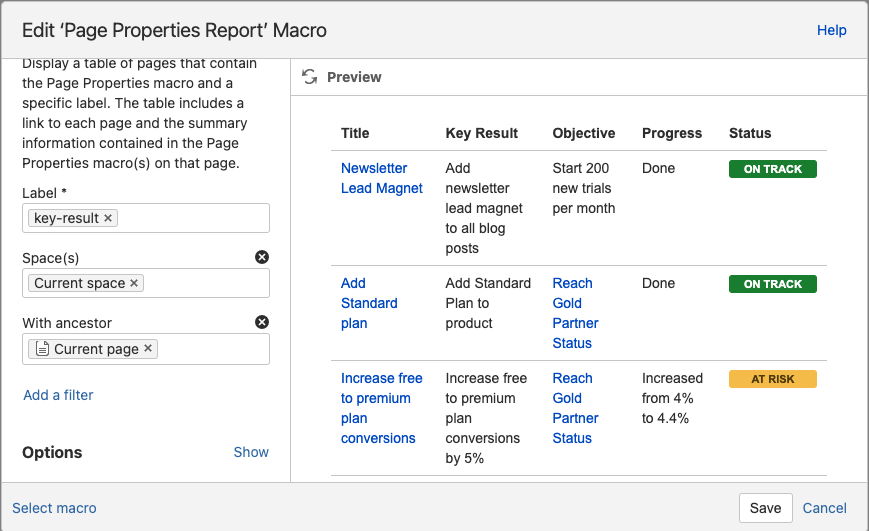
And voilá!
Every user who creates a new OKR with the help of your button will create a new structured Key result page, and the report will automatically include every new key result.
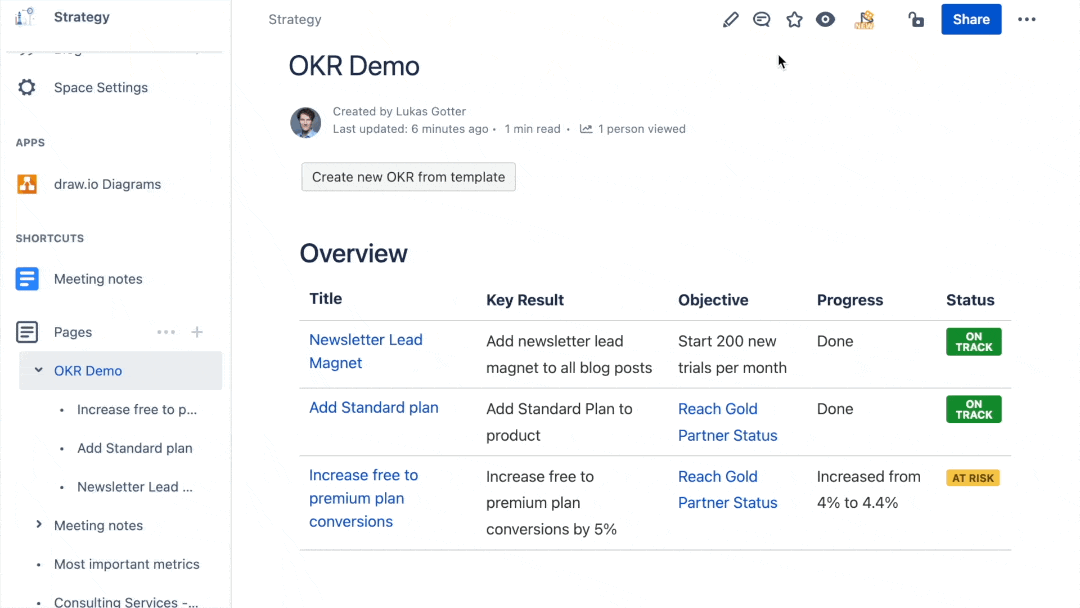
8. Templates for Meeting Notes
Maintaining control over sprawling meeting notes is one of the hardest tasks for project managers. With templates for Confluence Meeting Notes, you can use proper structure and allow participants to view and add data properly helping you to keep meetings productive and fun.
Many companies customize their meeting notes templates in Confluence. And we at Meetical certainly recommend that practice! Our Confluence App for better Meeting Notes fully supports native Confluence templates when creating your meeting notes from your calendar events. It will also apply any labels you define on templates and automatically use the right template for your recurring meetings. Remember to label your templates with "meetical-template" as described in our guide for How to create Meetical Templates.
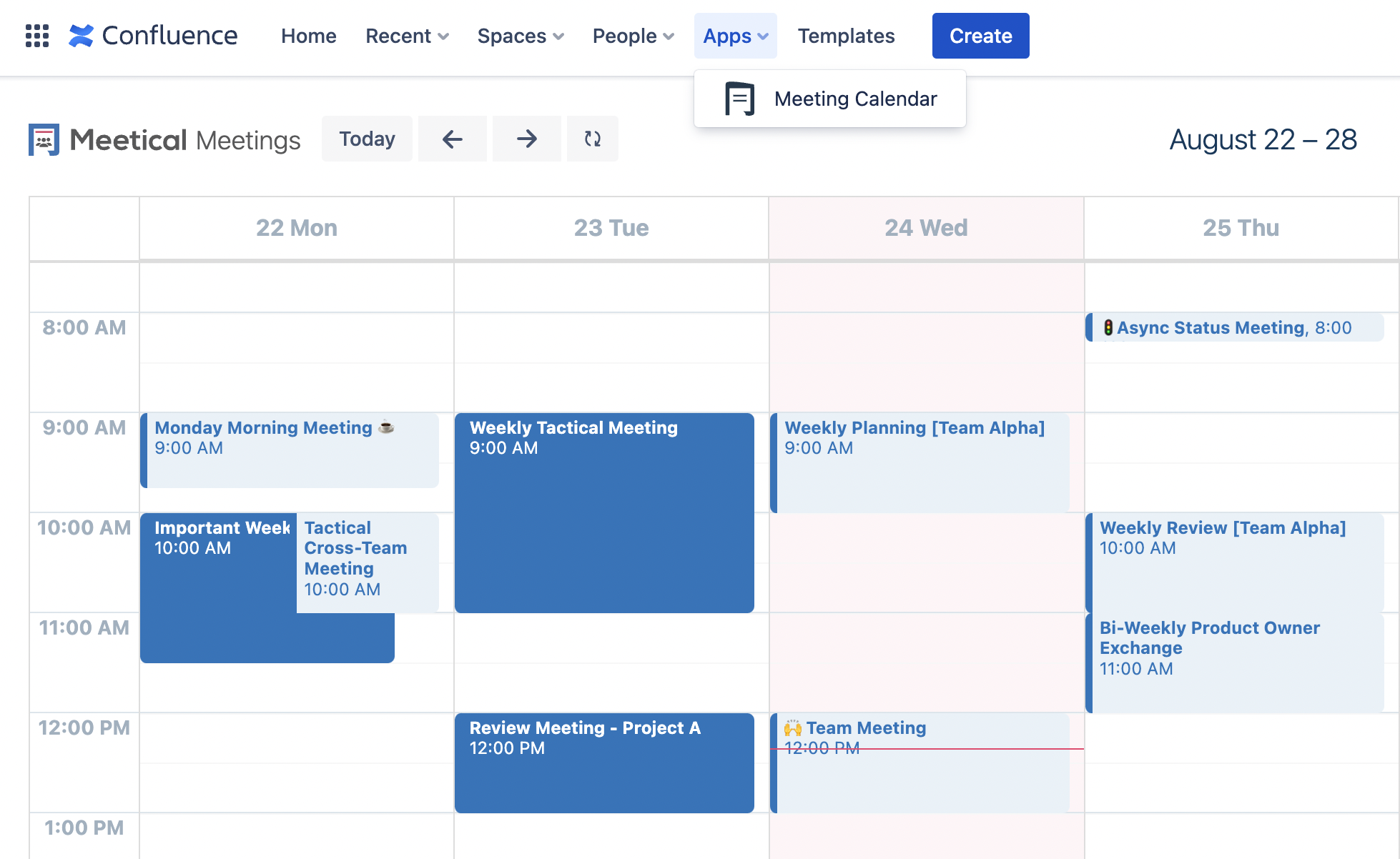
You can create your meeting notes from your defined templates from an internal Meeting Calendar, and use the free Confluence Chrome Extension / Outlook Add-in.
But even if you use Confluence without Meetical, customizing the existing template, or adding a template for your weekly team meeting can be very valuable. Copy-pasting existing pages from past meetings is not very effective and comes with the danger of duplicated action items and incomplete participant lists. The quality of your agendas and meeting notes will have a direct impact on meeting productivity!
To create or edit a meeting notes template in Confluence, follow the exact same steps as outlined already. In addition, always add the label “meeting-notes” to these templates, as all standard reports in Confluence will rely on that label. We also recommend including action items and decision macros, to promote the usage of these macros and make your content more structured.
Let’s now have a look at more best practices around Confluence templates.
9. Best Practices when Creating Templates in Confluence
Naming your templates
Since templates are all about bringing order to chaos, you cannot ignore naming them. Follow a straightforward naming convention to help people find the right template. On top of that, be descriptive and precise enough to stand out from other templates. For instance, if you're creating a template for interview notes, write something like “Job Interview ”. We recommend not including the word “Template” in the template name, to follow the same naming convention as the built-in templates.
Always include a description
It’s very important to always include a description of your template. Let users know what this template is good for, and what it might not be helpful for. You might also mention side effects, like the fact that a bunch of labels will be added, and in which reports the pages created from such templates will appear.
Use the Create from Template button
The create from template button mentioned has one big advantage when compared with the approach of using the template library: It will create the page under the current page, and thus the pages are under the correct parent. Use it whenever you can to reduce misplaced pages. – When using the Meetical App, for meeting notes use the alternative "Create from Meeting Calendar" macro.
Prefer Space Templates when getting started
Large organizations create enormous volumes of content every day. From product roadmap and marketing strategy to annual reports—everything needs to be documented. To avoid clutter, create space templates for specific spaces and use your personal space for experiments. Don’t forget to promote your space templates as described earlier to make sure they stay at the top and get more visibility.
Carefully consider what templates should get created on a global level. Global templates need to have macros that are not tied to any space and have very good titles and descriptions for easy access and correct usage.
Define page labels on templates
As we’ve already seen, it’s possible to define labels on templates, and have them added automatically to each page created from that template.
As we already mentioned, if you modify your meeting notes template(s), make sure you add the label “meeting-notes” to the template, since all standard reports on Confluence will use that label. And you want to make sure the pages created from your template are included.
In addition, for every template, always apply at least 1 label to be added to each page created from that template. This way you can relate the page to the template later on. This will help you and your users leverage reporting macros such as the Content by Label Macro to keep an overview of the content created.
Prefer Placeholders over Template variables
Template variables are currently quite limited on Confluence Cloud. Although they support both text and multiple-choice options, those options need to be managed by someone, manually. It’s preferred to use placeholder or example text over hard-coded, textual template variables.
For example, don’t use a template variable to specify a document @owner. Since you cannot use mentions in text-based variables. Use a placeholder instead! Or, if you want your template users to include status, instead of a hard-coded variable list, just add all statues with the color-coded native status macro. This allows users to easily add a new status if required, without the need to modify the template. Confluence is powerful and you can use it as some sort of database, yes, but keep in mind that it’s intentionally semi-structured, it’s still documents you categorize and organize, and not a rigid database.
10. Summary
If you have reached this far, congrats, have a chocolate! You should have a good idea of how to create a great template in Confluence. The template feature is certainly one of the most powerful things in Confluence when it comes to standardization and productivity.
We’ve seen why and how to create your own templates in Confluence, both covering space templates, and global templates.
We dived into how to publish your template, make it available to third-party apps such as Meetical, and how use your personal space as a safe playground to test drive and prototype your templates.
Then we had a closer look at all Macros which can be useful on Confluence templates, with a focus on using macros to add context and generate dynamic reports based on all sub-pages. In that section, we also discovered how to combine page properties, labels, and reports to create semi-structured databases based on Confluence templates.
It might have started with you searching for Confluence Create Template on the web, but now you just ended up going from zero to hero with Templates for Confluence! Hope you enjoyed it, thanks for reading!
We’d love to hear your feedback, reach out to us via info@meetical.io, and make sure you follow us on LinkedIn.




